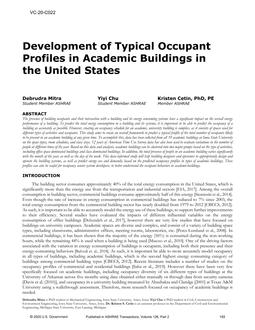
VC-20-C022 — Development of Typical Occupant Profiles in Academic Buildings in the United States
- Comments Off on VC-20-C022 — Development of Typical Occupant Profiles in Academic Buildings in the United States
- ASHRAE
Click here to purchase
The presence of building occupants and their interaction with a building and its energy consuming systems have a significant impact on the overall energy performance of a building. To predict the total energy consumption in a building and its systems, it is important to be able to predict the occupancy of a building as accurately as possible. However, creating an occupancy schedule for an academic, university building is complex, as it consists of spaces used for different types of activities and occupants. This study aims to create an overall framework to predict a typical profile of the total number of occupants likely to be present in an academic building at any given time. To accomplish this, data has been collected from all 39 academic buildings at Iowa State University on the space types, room schedules, and class sizes. 12 years of American Time Use Survey data has also been used to evaluate variations in the number of people at different times of the year. Based on this data and analysis, academic buildings can be clustered into two major groups based on the type of activities, including office space dominated buildings and class dominated buildings. In addition, the total presence of people in an academic building varies significantly with the month of the year, as well as the day of the week. This data-informed study will help building designers and operators to appropriately design and operate the building systems, as well as predict energy use and demands, based on the predicted occupancy profiles in types of academic buildings. These profiles can also be useful for occupancy sensor system developers, to better understand the occupant behaviors in academic buildings.
Citation: 2020 Virtual Conference Papers
Product Details
- Published:
- 2020
- Number of Pages:
- 9
- Units of Measure:
- Dual
- File Size:
- 1 file , 1.4 MB
- Product Code(s):
- D-VC-20-C022

